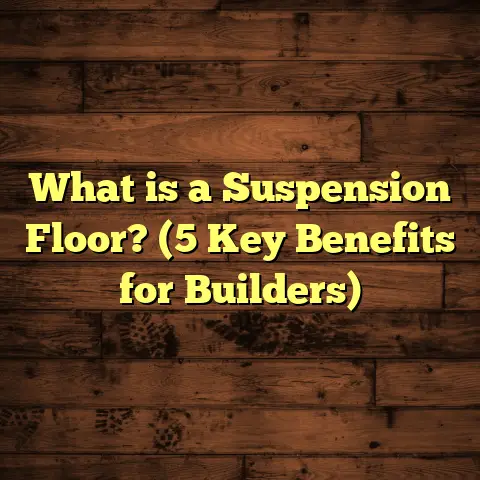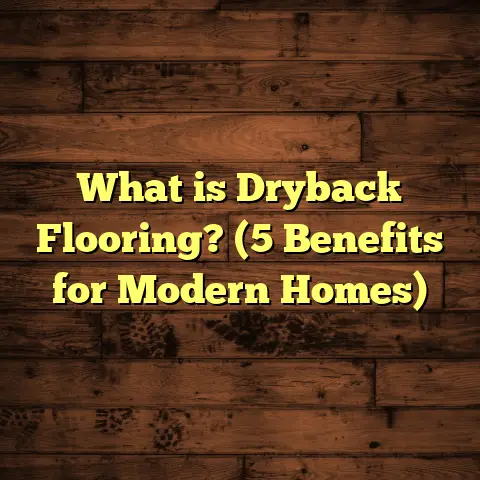What is Textile Floor Covering? (5 Benefits You Need to Know)
The art of floor covering has roots that stretch back thousands of years. I’ve always found it fascinating that ancient civilizations like the Egyptians and Persians didn’t just settle for cold stone or dirt floors. Instead, they crafted woven textile coverings to bring warmth and a touch of luxury to their homes and palaces. These early floor coverings were both practical and decorative, providing insulation against the chill and softness underfoot, much like modern carpets do today.
As someone who has worked in flooring for over a decade, I can tell you that textile floor coverings still carry those same qualities—comfort, style, and function—all carefully evolving with modern materials and design trends. Over the years, I’ve helped countless homeowners decide whether textile flooring is right for their space, and I’ve gathered some insights that might help you make that choice too.
What Is Textile Floor Covering?
At its core, textile floor covering refers to any flooring made from fibers woven, tufted, knitted, or bonded together. These fibers can be natural or synthetic and are designed to create surfaces that are soft and comfortable to walk on.
You might think of carpets immediately when you hear “textile flooring,” but the category also includes rugs, carpet tiles, mats, and sometimes woven fiber floor panels. They can cover an entire room wall to wall or be used as accent pieces that bring color and texture to a space.
When I explain textile floor covering to clients, I focus less on the technical definition and more on what it can do for their home. Would you like a floor that feels warm in winter? One that muffles sound so your rooms feel cozy? Or maybe something that helps define a living area with style? Textile floor coverings offer all these benefits—and more.
The Many Materials Behind Textile Flooring
Over the years, I’ve realized that knowing the fiber type is key to picking the right textile floor covering for your needs. Here’s a quick overview of common materials:
- Wool: The classic choice for luxury carpets. Wool is durable, naturally stain-resistant, and feels amazing underfoot. It’s also renewable and biodegradable.
- Nylon: One of the most popular synthetic fibers used in carpets due to its strength, resilience, and affordability.
- Polyester: Known for its vibrant color options and softness but not as durable as nylon.
- Olefin (Polypropylene): Great for moisture resistance; commonly used in outdoor rugs.
- Natural fibers (jute, sisal, coir): Made from plant fibers; they bring an earthy texture but tend to be rougher and less cushioned.
Depending on your lifestyle—pets, children, allergies—you might lean towards one fiber over another. I’ve seen families choose soft wool for bedrooms while opting for durable nylon carpets in high-traffic areas like hallways.
1. Comfort That Makes Everyday Life Better
If you’ve ever walked barefoot on tile or hardwood and wished it felt softer, textile floor coverings might be your answer. One of the biggest reasons people choose carpet or rugs is because of the comfort they add.
From personal experience, I remember helping a client who had chronic foot pain. After installing thick wool carpeting in her family room and bedrooms, she told me it made a huge difference in how her feet felt at the end of the day. She wasn’t alone; many people find that cushioned floors reduce pressure on joints.
Why does this happen? Textile floors distribute your body weight more evenly and absorb impact better than hard surfaces. Research from the American Podiatric Medical Association supports this: cushioned surfaces reduce strain on feet by around 30%, which can help prevent fatigue and discomfort.
Pro tip: Look for carpets with higher pile height (the length of carpet fibers) or denser construction. Both increase cushioning but remember higher piles may trap more dust.
Personal Story: The Kitchen Comfort Challenge
I once worked on a kitchen remodel where my client spent long hours cooking and entertaining. She complained about sore feet after standing on tile for years. We installed a low-pile nylon carpet tile with extra padding beneath.
The result? She told me she could stand comfortably for hours without pain. This small change made her daily routine so much easier—and that’s what good flooring should do: support your lifestyle.
2. Noise Reduction You Can Actually Hear
Do you live in an apartment or multi-story house where footsteps echo loudly? Textile floor coverings are great at reducing noise because their fibers absorb sound waves instead of reflecting them like hard surfaces do.
In office settings where noise distractions impact productivity, carpeting can cut down ambient noise by 20-50%, according to studies by the Acoustical Society of America. In homes, this means quieter rooms where conversations don’t need to be raised.
Case Study: Apartment Renovation Success
I managed a project in a busy apartment complex where neighbors complained about loud footsteps from upstairs units. We installed wall-to-wall carpets with high-density padding in all affected apartments.
The feedback was overwhelmingly positive—noise complaints dropped by over 60% within months. Tenants reported improved sleep quality and less stress from constant noise interruptions.
If you have kids or pets running around—or if you just want peace and quiet—textile floor coverings might be worth considering.
3. Style Variety That Lets You Express Yourself
One surprising thing I often notice is how people underestimate the design potential of textile floor coverings. There’s truly no limit to what you can create with colors, patterns, textures, and layering.
During one project for a young couple who loved bold design statements, we selected bright geometric patterned rugs layered over neutral wall-to-wall carpet in living areas. The result was a dynamic space full of personality but still cozy underfoot.
Exploring Trends: Texture Is King
Recently, texture has become a huge trend in flooring design. Think looped piles, cut piles, shag rugs, woven jute mats—each adds tactile interest that changes how a room feels.
Did you know? In surveys conducted by interior designers, over 70% say texture is one of the key elements they focus on when choosing textiles for floors. It’s an easy way to add depth without repainting walls or buying new furniture.
How To Mix And Match Rugs Like A Pro
One trick I use often is layering different rugs to add contrast and warmth. For example:
- Start with a large neutral base rug (wool or synthetic)
- Add a smaller patterned rug on top (natural fiber or colorful synthetic)
- Finish with a runner or accent rug near entryways or beds
This combination creates a balanced yet interesting look with visual appeal and comfort.
4. Maintenance Made Manageable
People sometimes hesitate to choose textile floor coverings thinking they’ll be hard to keep clean. From my experience working on projects with pets and kids, that’s not necessarily true if you pick the right materials and follow simple care steps.
Here’s what I always tell clients:
- Vacuum regularly—twice weekly is ideal—to remove dust and dirt before it settles deep.
- Address spills immediately with appropriate cleaners.
- Schedule professional deep cleaning once a year or every 18 months.
- Use protective pads under furniture to avoid crushing fibers.
Data On Carpet Longevity
According to the Carpet and Rug Institute (CRI), regular vacuuming removes up to 80% of soil in carpet fibers—a huge difference in maintaining carpet life.
Synthetic fibers like nylon are especially great because they resist stains better than natural fibers. Wool carpets need more gentle care but are naturally dirt-resistant due to their fiber structure.
Real-Life Example: Pet-Friendly Flooring
I installed nylon carpet tiles for a client with two large dogs who worried about stains and odors. We added stain-resistant treatments and recommended enzyme-based cleaners for pet accidents.
After two years, their carpets looked almost new with only occasional spot cleaning. They were thrilled they didn’t have to replace floors prematurely due to wear or damage.
5. Eco Options That Help The Planet
Sustainability is becoming more important in every part of home design—including flooring. Textile floor coverings have made big strides in eco-friendliness thanks to advances in manufacturing and recycling.
I recently helped a client choose carpets made from 100% recycled PET plastic bottles. Not only did this reduce landfill waste, but these carpets also had low VOC emissions—meaning better air quality indoors.
Natural fiber carpets like jute, sisal, hemp, and coir are also popular among environmentally-conscious consumers because they biodegrade at end-of-life unlike many synthetics.
Research On Environmental Impact
A Life Cycle Assessment (LCA) study by the Sustainable Carpet Initiative found recycled PET carpets reduce greenhouse gas emissions by approximately 40% compared to traditional nylon carpets during production.
It’s encouraging to see manufacturers offering certifications such as Green Label Plus which guarantees low chemical emissions—something I always check when selecting products for clients sensitive to indoor air quality.
Additional Insights Based On My Experience
Choosing The Right Textile Floor Covering For Your Space
When clients ask me what textile floor covering suits their needs best, I always start by asking questions:
- How much foot traffic does the area get?
- Are there pets or children?
- Do you want something plush or something easy to maintain?
- What’s your budget?
- What look are you trying to achieve?
Answering these helps narrow down choices significantly. For example:
- High traffic + budget-friendly = low-pile nylon carpet tiles.
- Luxury bedroom = thick wool carpet.
- Eco-conscious buyer = recycled PET or natural fiber rugs.
- Allergy concerns = hypoallergenic synthetics with frequent cleaning.
Budgeting Tips
Textile flooring costs vary widely based on fiber type, pile density, brand, installation method, and location. On average:
- Synthetic carpet runs $2-$5 per square foot (material only).
- Wool carpets can cost $5-$15 per square foot.
- Carpet tiles cost $3-$7 per square foot.
- Rugs start as low as $50 but vary dramatically based on size/material.
Installation usually adds $1-$3 per square foot depending on complexity.
Using tools like FloorTally helps me give clients accurate estimates tailored to their choices and local labor rates—very helpful for realistic budgeting.
Common Challenges And Solutions
Stains & Spills:
I recommend quick action plus using protective treatments during installation such as Scotchgard. Some carpets come pre-treated for stain resistance.
Wear & Tear:
Choose higher-quality dense carpets for durability in busy areas. Carpet tiles allow replacing worn sections easily without removing entire floors.
Allergies:
Use vacuum cleaners with HEPA filters regularly. Opt for synthetic fibers less likely to harbor dust mites than wool if allergies are severe.
Final Thoughts After Years Of Flooring Work
Textile floor coverings offer benefits that go beyond just looking good—they add comfort, quietness, style flexibility, manageable maintenance, and even environmental benefits. If you want a floor that invites you in at the end of long days and fits your lifestyle needs without sacrificing personality—textiles are worth considering seriously.
If you’re uncertain where to start: try adding an area rug in your living room or bedroom first. Feel how it changes your experience daily before investing in wall-to-wall carpet.
Have you tried textile flooring in your home? What did you love or dislike about it? Feel free to ask me about options that fit your needs—I’m happy to share what works based on real projects I’ve worked on over the years!





